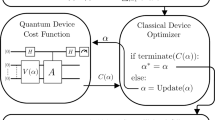Abstract
Quantum linear system algorithms (QLSAs) for gate-based quantum computing can provide exponential speedups for solving linear systems but face challenges when applied to finite element problems due to the growth of the condition number with problem size. Furthermore, QLSAs cannot use an approximate solution or initial guess to output an improved solution. Here, we present quantum relaxation for linear system (qRLS), as an iterative approach for gate-based quantum computers by embedding linear stationary iterations into a larger block linear system. The condition number of the block linear system scales linearly with the number of iterations independent of the size and condition number of the original system. The well-conditioned system enables a practical iterative solution of finite element problems using the state-of-the-art quantum signal processing (QSP) variant of QLSAs, for which we provide numerical results using a quantum computer simulator. The iteration complexity demonstrates favorable scaling relative to classical architectures, as the solution time is independent of system size and requires O(log(N)) qubits. This represents an exponential efficiency gain, offering a new approach for iterative finite element problem-solving on quantum hardware.



























Similar content being viewed by others
Data availability
We do not have a data availability statement.
References
Harrow AW, Hassidim A, Lloyd S (2009) Quantum algorithm for linear systems of equations. Phys Rev Lett 103(15):1–15. https://doi.org/10.1103/PhysRevLett.103.150502
Martyn JM, Rossi ZM, Tan AK, Chuang IL (2021) Grand unification of quantum algorithms. PRX Quantum 2(4):1. https://doi.org/10.1103/PRXQuantum.2.040203
Montanaro A, Pallister S (2016) Quantum algorithms and the finite element method. Phys Rev A 93(3):1–16. https://doi.org/10.1103/PhysRevA.93.032324
Feynman RP (1986) Quantum mechanical computers. Found Phys 16(6):507–531. https://doi.org/10.1007/BF01886518
Shor PW (1994) Algorithms for quantum computation: discrete logarithms and factoring. In: Proceedings 35th annual symposium on foundations of computer science, 1994, pp 124–134. https://doi.org/10.1109/SFCS.1994.365700.
Berry DW (2014) High-order quantum algorithm for solving linear differential equations. J Phys A Math Theor 47(10):1–14. https://doi.org/10.1088/1751-8113/47/10/105301
Childs AM, Liu J-P, Ostrander A (2020) High-precision quantum algorithms for partial differential equations. 1–38 [Online]. Available: http://arxiv.org/abs/2002.07868
Nielsen MA, Chuang IL (2011) Quantum computation and quantum information: 10th anniversary edition. https://doi.org/10.1017/CBO9780511976667
Finnila AB, Gomez MA, Sebenik C, Stenson C, Doll JD (1994) Quantum annealing: a new method for minimizing multidimensional functions. Chem Phys Lett 219(5–6):343–348. https://doi.org/10.1016/0009-2614(94)00117-0
Born M, Fock V (1928) Beweis des Adiabatensatzes. Zeitschrift für Phys 51(3):165–180. https://doi.org/10.1007/BF01343193
Acharya R et al (2023) Suppressing quantum errors by scaling a surface code logical qubit. Nature 614(7949):676–681. https://doi.org/10.1038/s41586-022-05434-1
King J, Yarkoni S, Nevisi MM, Hilton JP, Mcgeoch CC (2015) Benchmarking a quantum annealing processor with the time-to-target metric. https://doi.org/10.48550/arXiv.1508.05087
Raisuddin OM, De S (2022) FEqa: finite element computations on quantum annealers. Comput Methods Appl Mech Eng 395:115014. https://doi.org/10.1016/j.cma.2022.115014
Childs AM, Kothari R, Somma RD (2017) Quantum algorithm for systems of linear equations with exponentially improved dependence on precision. SIAM J Comput. https://doi.org/10.1137/16M1087072
Clader BD, Jacobs BC, Sprouse CR (2013) Preconditioned quantum linear system algorithm. Phys Rev Lett 110(25):1–5. https://doi.org/10.1103/PhysRevLett.110.250504
Wang G (2017) Efficient quantum algorithms for analyzing large sparse electrical networks. Quantum Inf Comput 17(11–12):987–1026. https://doi.org/10.26421/qic17.11-12-5
Dong Y, Meng X, Whaley KB, Lin L (2021) Efficient phase-factor evaluation in quantum signal processing. Phys Rev A 103(4):42419. https://doi.org/10.1103/PhysRevA.103.042419
Orsucci D, Dunjko V (2021) On solving classes of positive-definite quantum linear systems with quadratically improved runtime in the condition number. Quantum 5:1–49. https://doi.org/10.22331/Q-2021-11-08-573
Leyton SK, Osborne TJ (2008) A quantum algorithm to solve nonlinear differential equations. 1–11 [Online]. Available: http://arxiv.org/abs/0812.4423
Berry DW (2014) High-order quantum algorithm for solving linear differential equations. J Phys A Math Theor. https://doi.org/10.1088/1751-8113/47/10/105301
Lloyd S et al (2020) Quantum algorithm for nonlinear differential equations. 1–17 [Online]. Available: http://arxiv.org/abs/2011.06571
Liu JP, Kolden HØ, Krovi HK, Loureiro NF, Trivisa K, Childs AM (2021) Efficient quantum algorithm for dissipative nonlinear differential equations. Proc Natl Acad Sci USA 118(35):1–6. https://doi.org/10.1073/pnas.2026805118
Kyriienko O, Paine AE, Elfving VE (2021) Solving nonlinear differential equations with differentiable quantum circuits. Phys Rev A 103(5):1–22. https://doi.org/10.1103/PhysRevA.103.052416
An D, Fang D, Lin L (2022) Time-dependent Hamiltonian simulation of highly oscillatory dynamics and superconvergence for Schrödinger equation. Quantum 6:1–41. https://doi.org/10.22331/Q-2022-04-15-690
Childs AM, Liu JP, Ostrander A (2020) High-precision quantum algorithms for partial differential equations. Quantum 5:1–40. https://doi.org/10.22331/Q-2021-11-10-574
Arrazola JM, Kalajdzievski T, Weedbrook C, Lloyd S (2019) Quantum algorithm for nonhomogeneous linear partial differential equations. Phys Rev A 100(3):32306. https://doi.org/10.1103/PhysRevA.100.032306
Trefethen LN, Bau D (1997) Numerical linear algebra. https://doi.org/10.1137/1.9780898719574
Briggs WL, Henson VE, McCormick SF (2000) A multigrid tutorial, Second Edition. https://doi.org/10.1137/1.9780898719505
Axelsson O (1994) Iterative solution methods. Cambridge University Press, Cambridge. https://doi.org/10.1017/CBO9780511624100
Berry DW, Childs AM, Ostrander A, Wang G (2017) Quantum algorithm for linear differential equations with exponentially improved dependence on precision. Commun Math Phys 356(3):1057–1081. https://doi.org/10.1007/s00220-017-3002-y
Carrera Vázquez A, Wörner S, Hiptmair R (2018) Quantum algorithm for solving tri-diagonal linear systems of equations. 1–24
Cappanera E (2021) Variational quantum linear solver for finite element problems: a Poisson equation test case. TU Delft, Delft
Qiskit Contributors (2023) Qiskit: an open-source framework for quantum computing. https://doi.org/10.5281/zenodo.2573505
Fang D, Lin L, Tong Y (2023) Time-marching based quantum solvers for time-dependent linear differential equations. Quantum 7:1–45. https://doi.org/10.22331/Q-2023-03-20-955
Costa PCS, An D, Sanders YR, Su Y, Babbush R, Berry DW (2022) Optimal scaling quantum linear-systems solver via discrete adiabatic theorem. PRX Quantum 3(4):1. https://doi.org/10.1103/PRXQuantum.3.040303
Acknowledgements
The authors would like to acknowledge the support of this work by NIBIB R01EB0005807, R01EB25241, R01EB033674 and R01EB032820 grants.
Author information
Authors and Affiliations
Corresponding author
Ethics declarations
Conflict of interest
The authors have no competing interests to declare that are relevant to the content of this article.
Additional information
Publisher's Note
Springer Nature remains neutral with regard to jurisdictional claims in published maps and institutional affiliations.
Rights and permissions
Springer Nature or its licensor (e.g. a society or other partner) holds exclusive rights to this article under a publishing agreement with the author(s) or other rightsholder(s); author self-archiving of the accepted manuscript version of this article is solely governed by the terms of such publishing agreement and applicable law.
About this article
Cite this article
Raisuddin, O., De, S. qRLS: quantum relaxation for linear systems in finite element analysis. Engineering with Computers (2024). https://doi.org/10.1007/s00366-024-01975-3
Received:
Accepted:
Published:
DOI: https://doi.org/10.1007/s00366-024-01975-3




